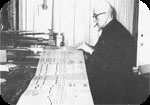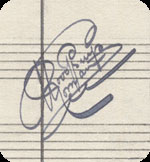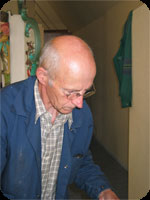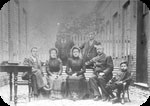 |
| Home
History |
| Part 3: nothing lasts forever … | |
The
bloom of the Hooghuys firm lasted till the First World War; afterwards,
the production was rather limited. Organs from before 1914-1918
were built up to the highest standards, without any compromise;
instruments from after the war had be produced at a cheaper rate.
To support his organ building business after 1918, Louis sold gramophones
and records (a.o. of the Zonophone-company) – although he already
did this before 1910: originally, these sales were not necessary
as a source of income. It is also important to know that Louis
was a very conservative man: illustrative is the fact that he refused
to build organs with 12 basses; he kept to the old scale with 8
basses. Moreover, he didn't give several of his instruments a chromatic
scale, while other organ builders did so.
Louis François died on 16 November 1924 after a protracted illness.
After his death, the firm actually ceased to exist. The main
reason for this stop were the disagreements between Louis' two
eldest sons: Charles François (1878-1951) and Edmond François
(1882-1963). One of the reasons for this discord was the fact
that after the death of his first wife (Maria Hortensia De Vlaeminck, 1854-1912), Louis had married (in 1912) a much
younger woman (Elisa Maetens, 1884-1918). |
|
Charles
François Hooghuys, born in Geraardsbergen on 15 April 1878, was
the eldest son of Louis but was not so talented as Edmond both
on craftmanship and music. For that reason, and because Louis François
did better get on with Edmond, Louis François considered the latter
as his successor – something Charles couldn't stand. Edmond
kept on restoring and tuning organs until his death in 1963, while
Charles stopped all activities at latest in 1939 (probably even
earlier). Although there are some Hooghuys organs with the name
"Ch.Hooghuys" on it, it should be mentioned that Charles
François probably never built a completely new organ himself, but
only finished some work that was left when his father died and
maintained some organs. At the time of Louis' death, two organs
were still to be completed: the LH650 (84-key) and LH670 (58-key),
now both in the possession of Jasper Sanfilippo in Illinois (USA).
Charles also assembled the 70-key CH660 (now owned by Teddy Reed
in Amersham (UK)) and he provided some organs with a Hooghuys key
frame: the CH655 (51-key, originally a Ruth), the CH665 (51-key,
builder unknown), the CH675 (78-key, built by Pierre Eich, no longer
extant) and the CH680 (73-key, originally a Wellershaus). Charles
also maintained some organs.
After the death of Louis, Charles bought half
of the factory building at the Place de la Station (the other part
was sold to a furniture manufacturer). In that house, he opened
a café for the brewery "Zeeberg" from Aalst; where he
placed a Hooghuys dance organ (the LH620, now in possession of
Bill Nunn (USA)). He sold this instrument to a showman in 1931.
In 1938 Charles sold his house and workshop to the brewerey mentioned
above but it was only in 1940 that he moved to another address
(Kloosterstraat 24), while his only son Romain Charles took over
the café for a while. |
In 1944, Romain left Geraardsbergen for some reason, and went to live in Galmaarden (B). There he opened a shop for newspapers, magazines, stationery and sweets. He also had a commerce in coffee for a certain time, and was occasionally organist in the local church . In 1951, after his father's death, he moved back to Geraardsbergen with his family to live with his mother in the Kloosterstreet 12. Two years later, in 1953, he moved to the Belgian coast; he lived successively in Zuienkerke, Lissewege, Wenduine, Zeebrugge and Brugge.
It was in Lissewege in about 1955 that he purchased the LH615 (83-key), which is now in the museum at Utrecht (NL), and from then on he sporadically started cutting cardboard music again. In the early sixties, he bought the LH507 (93-key), a dance organ with the Gavioli G4-scale (the Hooghuys firm built several organs with this scale). Unfortunately, he dismantled this organ to have spare parts. In November 1963, he bought the 72-key LH518 – better known as the "Senior" – and from 1968 on, he played with that organ on a folkloristic market in Knokke-Heist (B) every year on Thursday afternoon during summer; it was from that time on that he started fulltime cutting organ books again.
Around 1965, he bought (at a comparatively low price) the LH605 (97-key), which he called the "Condor", and in October 1971, he purchased the LH552 (73-key), which is now in the possession of Romain's son Marc (now it is named "Albatross").
Romain Charles kept on arranging music for his organs until 1978, when he moved to Brugge, near the Boudewijnpark (a theme park). There he made about another ten books, but in about 1985, when his wife's health began to fail, he stopped cutting books for ever. On 15 December 1989, he died after being severely injured in an accident. His wife died on the day of his funeral …
Fortunately, Romain Charles had a worthy successor in his son, Marc Herwig Hooghuys, who was actually the last member of the Hooghuys family who engaged himself in the world of mechanical organs. In this field, he did more than an excellent job. Apart from maintaining other Hooghuys organs, he also restored his own Hooghuys organ, the above mentioned 73-key "Albatross".
 |
 |
 |
Romain
Charles – with the inevitable cigar – at his punching machine. |
||
Early
signature of Romain
Charles Hooghuys |
Marc Hooghuys
working on LH553 |
|



